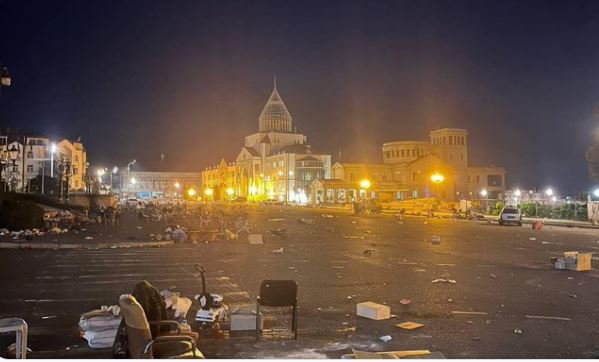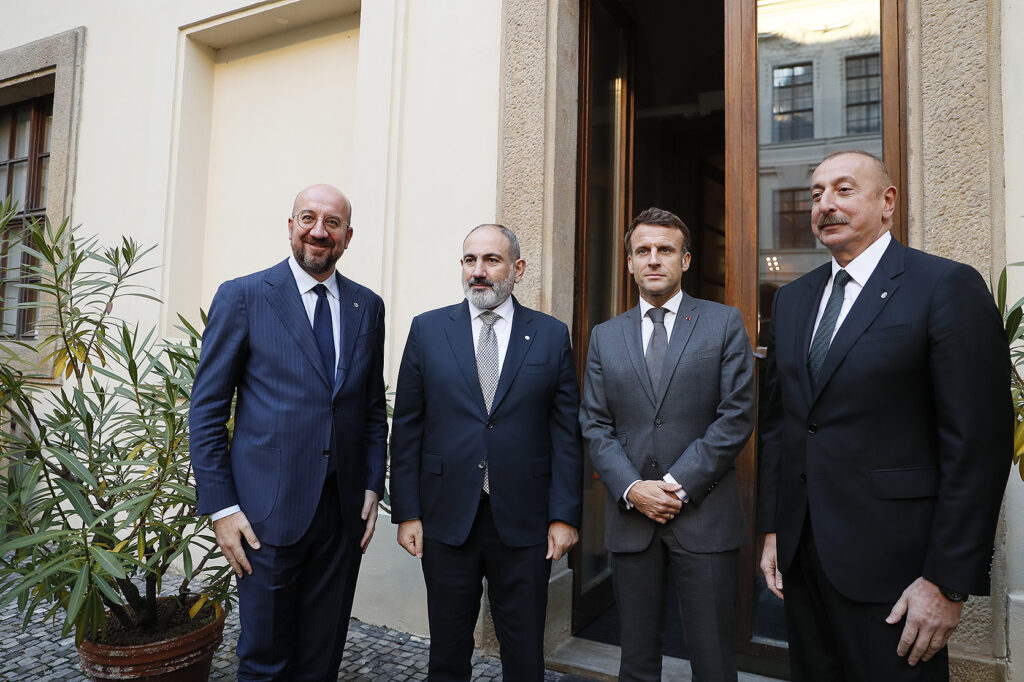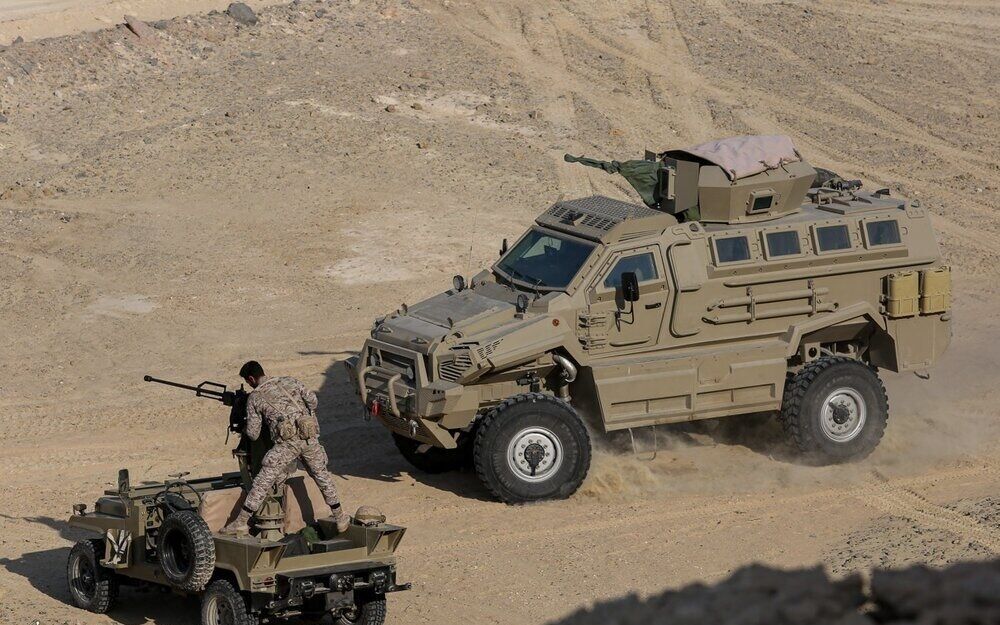What Happened
The President of Azerbaijan, Ilham Aliyev, has claimed that peace with Armenia is closer “than ever before.” He made the claim in a joint press conference with NATO Secretary General Jens Stoltenberg, who was in Azerbaijan in order to hold a series of meetings with Aliyev. Secretary Stoltenberg travelled to Armenia on Tuesday in order to hold talks with Armenian Prime Minister Nikol Pashinyan. Both meetings will be gone over in detail.
Notably, following Aliyev’s claims, PM Pashinyan signalled his willingness to hand over four disputed border villages to Azerbaijan, claiming that Azerbaijan could attack Armenia “by the end of the week” if Armenia did not hand over the four villages. This claim was given amidst discussions with Armenian locals who live in close proximity to the villages.
The villages, Baganis Ayrim, Asagi Askipara, Xeyrimli, and Gezilxajili, are located in Azeri recognized territory, however have been uninhabited since they were occupied by Armenia in the early 1990’s during the first Karabakh/Artsakh war.
Armenian civilians in villages located in close proximity to the occupied villages have expressed concerns about the potential return of the villages, with many fearing for their safety and also ability to access their land. Several border villages in Armenia have been partially or fully evacuated due to repeat problems with Azeri soldiers stationed on positions which were near the villages.

The four villages are located by a major highway which links Armenia to Georgia, as well as a pipeline which delivers Russian natural gas through Georgia. PM Pashinyan has spoken of plans to reroute this infrastructure through Armenia’s territory in the event of a handover.
The villages, along with four others which lie in Azeri exclaves within Armenia that are also occupied by Armenia, have been a prerequisite for Azerbaijan before they agree to signing any peace deal with Armenia. Notably, Azerbaijan is not handing back any territory of Armenia’s which it occupies, the estimates of which range as high as 250km2, the majority of which was seized in 2022 when Azerbaijan launched a series of attacks on Armenia’s borders.
The villages are all centred around Armenia’s Tavush region.
Meetings in Azerbaijan
During a joint press conference in Azerbaijan, President Aliyev and Secretary Stoltenberg spoke of previous cooperation between NATO and Azerbaijan, but also of enhancing future cooperation, particularly in the energy sector. As Aliyev mentioned, “today, Azerbaijan is exporting natural gas to eight countries, six of which are member states of NATO, and two are partners to NATO.”

The enhanced energy cooperation is a byproduct of the Russian invasion of Ukraine. As Europe searched for alternatives to Russian oil and gas, Azerbaijan has presented itself as one such alternative, signing a number of contracts with European countries and the wider EU.
Aliyev further added that “the European Commission calls Azerbaijan a reliable partner”. This is in reference to a statement made by certain EU Commission politicians which had referred to Azerbaijan as a reliable partner. In an EU resolution passed last week, the EU condemned these statements, saying that “these statements do not reflect the position of the European Union.”
Regarding conflicts with Armenia, Aliyev spoke about the previous “occupation of Azerbaijani lands by Armenia.” He went on to say that Azerbaijan “restored its territorial integrity and sovereignty” in both the 2020 44-Day war (also known as the second Nagorno-Karabakh/Artsakh war), as well as the September 2023 “anti-terror operation.”
The “anti-terror operation” was a lightning attack carried out by Azerbaijan against Artsakh separatist forces in September of 2023, which was carried out after an approximately nine month long blockade that Azerbaijan had on the region, which prompted the capitulation of Artsakh’s government. The impending Azeri takeover of Artsakh resulted in the vast majority of the region’s 120,000 Armenians performing a mass exodus to Armenia proper.

Aliyev stated the September operation was carried out in accordance with Azerbaijan’s “right for self-defense based on the UN Charter.”
Aliyev hailed progress in peace negotiations with Armenia, claiming that peace was “closer than ever.” A large excerpt from Aliyev’s statement, at the end of which he makes the claim, may be read below.
“During many years of our discussions, we always talked about the occupation of Azerbaijani lands by Armenia. But now, for more than three years, these issues have been out of the topics of discussions. Because Azerbaijan restored its territorial integrity and sovereignty during the Second Karabakh War of 2020 and the last September’s anti-terror operation. So, now full sovereignty over the territory of the country has been restored, and this is a good demonstration of how protracted conflicts can be resolved. The conflict was resolved by military-political means. We used our right for self-defense based on the UN Charter.
Today, we are in an active phase of peace talks with Armenia. During my last visit to Brussels, at the press conference, I raised that issue and said that Azerbaijan made such a proposal, and we expect Armenia to respond. Once again, I would like to say that it was our initiative to start peace negotiations. We have already had seven rounds of exchanges of comments with Armenian counterparts on a draft peace agreement. The recent meeting of the foreign ministers and also the meeting of the deputy prime ministers on the issue of border delimitation demonstrate that there is a good chance for settlement. As I said relatively recently, we are now closer to peace than ever before.”
Secretary Stoltenberg hailed the progress and offered his encouragement for continuing down the path. He also took the opportunity to attempt to drum up support for Ukraine. The portion of his statement regarding the matter may be read below.
“Armenia and Azerbaijan have an opportunity to achieve enduring peace after years of conflict. I appreciate what you say about you being closer to a peace agreement than ever before. I can just encourage you to seize this opportunity to reach a lasting peace agreement with Armenia. Then, it is also important to highlight that, of course, when you look at the broader region, Ukraine is a Black Sea country. It is a country that is a partner of NATO, and Russia continues to conduct war aggression against Ukraine. NATO allies are extremely concerned about the consequences of the ongoing war, and NATO allies provide support for Ukraine. I welcome the much-needed support that Azerbaijan provides to Ukraine. Also, when it comes to humanitarian aid, which is much needed, more support is needed because the situation in Ukraine is extremely difficult.”
Peace: Close or Far..?
This is not the first time that political leadership of any of the many nations involved in peace processes between Armenia and Azerbaijan has spoken of the proximity of a final peace deal, in order to solidify borders and formalize/normalize relations between Armenia and Azerbaijan.
In both 2022 and 2023, both sides expressed hopes that a final deal would be signed “by the end of the year.” Evidently, this has not happened. There are a number of key issues which remain in the way of signing such a deal.

One of these issues, until recently, was Artsakh. A primary concern of Armenian negotiators was the status both of Artsakh as well as the civilians within. While Armenia did not technically recognize Artsakh’s independence, it had a number of stakes in the region with Artsakh being economically dependent upon Armenia, as well as the region’s population being majority Armenian. Azerbaijan put an end to this question with their seizure of Artsakh and the exodus of the Armenian population.
While there are many smaller issues facing the signature of the peace deal, there are two specific ones in the forefront. Namely border demarcation, and the establishment of what is called the Zangezur corridor.
There are core disagreeances between Armenia and Azerbaijan on how border demarcation should be carried out, in particular regarding several occupied territories. PM Pashinyan has accused Azerbaijan of attempting to demarcate borders as they are presently, where Azerbaijan occupies a significant amount of Armenian territory. He said Azerbaijan is rejecting Armenia’s proposals on border demarcation in order to form justification for a future “full scale war” against Armenia.
“Our analysis shows that there may be one reason for this, and that reason may be, for example, the start of military operations in some parts of the border, with the prospect of turning the military escalation into a full-scale war against the Republic of Armenia” -PM Pashinyan
Armenia proposes the demarcation of the border based on the 1991 Alma-Ata Declaration, which established the borders of the two nations amidst the fall of the Soviet Union.
Pashinyan stated he has proposed a mutual withdrawal from occupied territories. In total, Armenia occupies eight Azeri villages; the four mentioned at the beginning of this article as well as the four which lie in Azeri exclaves. In turn, Pashinyan claims that Azerbaijan is presently occupying 31 Armenian villages.
The second of the most prominent issues is the establishment of what is called the Zangezur corridor. The corridor is to be a corridor which travels through Armenia’s south in order to connect the Azeri mainland to their Nakhchivan exclave.
The corridor’s establishment has witnessed a number of disagreeances on if, or if how, it should come to fruition.
Azerbaijan and Turkey have been insistent on the corridors creation without any Armenian checkpoints or customs checks, with Azerbaijan maintaining full control over the corridor. While initially resistant to the idea in any capacity, Armenia has relented a small bit and has offered the existence of the corridor, however they maintain control over it and can establish checkpoints and customs/security checks along the road. Azerbaijan has refused this option.
Iran, Armenia and Azerbaijan’s southern neighbour, has opposed the creation of the corridor in general, with fears it could cut off their border with Armenia. Iran has cautioned Azerbaijan against seeking any border changes, threatening to counter any attempts with “special resistance.” Although they have noticeably improved in the last decade or so, Iran has historically held ill relations with Azerbaijan.

Both Turkey and Azerbaijan have continually been insistent on the corridors creation.
Meetings in Armenia
Similar to the meetings in Azerbaijan, Secretary Stoltenberg hailed progress towards establishing a final peace deal between Armenia and Azerbaijan. PM Pashinyan spoke similarly of the progress, and Armenia’s willingness to commit to these processes. They both also spoke of enhancing cooperation between NATO and Armenia.
An excerpt of PM Pashinyan’s statement regarding peace negotiations with Azerbaijan, and with Turkey, may be read below.
“I presented to Mr. Stoltenberg the vision and approaches of the Government of the Republic of Armenia to establishing stability and peace in the South Caucasus. I reaffirm my repeatedly voiced willingness to normalize relations with Azerbaijan based on the 3 principles agreed at the highest level, namely, recognition of each other’s territorial integrity based on the Alma-Ata Declaration, the delimitation of the Armenia-Azerbaijan interstate border according to the Alma-Ata Declaration for restoring the border that existed at the time of the collapse of the USSR in 1991 between the two republics, as well as the unblocking of regional infrastructures, respecting the sovereignty and jurisdiction of the countries they pass through, based on the principles of equality and reciprocity. Regarding the latter, I have also presented the “Crossroads of Peace” project, which summarizes our ideas on the issue.
We expect the firm support of the international community, including NATO, for the peace process between Armenia and Azerbaijan based on known and mutually agreed upon principles, as well as the unequivocal rejection of the policy of coercion and threats.
I also presented to the General Secretary the proposals for a simultaneous withdrawal of troops from the Armenia-Azerbaijan border of 1991, mutual arms control, and the signing of a non-aggression pact, which have not received a positive response from official Baku to date.
We are also committed to the agenda of normalizing relations with Turkey. We believe that the implementation of the agreements reached with Turkey in 2022, which were subsequently reaffirmed, may have a positive impact on the establishment of stability in the South Caucasus region.”
To Russia’s condemnation, Armenia has grown steadily closer as of late with the west, including several NATO countries (namely France, Greece, and the US). The departure from Russia has seen Armenia send humanitarian aid to Ukraine, and PM Pashinyan hold talks with Ukrainian President Volodymyr Zelenskyy.

An excerpt from Secretary Stoltenberg’s statement relating to Armenian and Azeri peace processes, as well as regarding Ukraine, may be read below.
During today’s meeting, we discussed the importance of stability in the South Caucasus. This is important for Euro-Atlantic security as we face an increasingly dangerous world.
Today, Armenia and Azerbaijan have a chance to achieve lasting peace after years of conflict. This is why I call on the two countries to reach an agreement that will pave the way for normalization of relations and lasting peace for your peoples. NATO supports Armenia’s sovereignty, territorial integrity and your peaceful aspirations.
Russia’s war in Ukraine is a sobering reminder that we cannot help but value peace. I applaud your solidarity with Ukraine and call on all partners to do everything in their power to prevent Putin from winning his war of aggression. The situation on the battlefield remains critical, but this is precisely why our support should be increased, not decreased. If Putin succeeds in Ukraine, there is a real risk that his aggression will not stop there, and that other authoritarian entities will be inspired by it.
Notably, Secretary Stoltenberg also spoke of the “progress of Armenia’s domestic reforms”. Over the past several months, Armenia has carried out a number of democratic reforms of several of its institutions with the support of both France and the EU. More recently, Armenia’s Foreign Minister, Ararat Mirzoyan, announced that Armenia was considering applying to the EU. The EU last week passed a resolution which called for the EU to consider, and support, Armenia’s potential application.
Such democratic reforms are necessary for Armenia’s entry into the EU. With France and the EU promising to support further reforms, and having supported them previously, this suggests an EU application is not a new plan.


